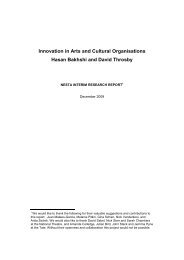Rumbling on performativity_Frits Simon
Rumbling on performativity_Frits Simon
Rumbling on performativity_Frits Simon
Create successful ePaper yourself
Turn your PDF publications into a flip-book with our unique Google optimized e-Paper software.
aut<strong>on</strong>omous entity (Foucault, 1966), Mead is held resp<strong>on</strong>sible for a Copernican revoluti<strong>on</strong><br />
in social psychology by articulating a pragmatist and processual view of reality<br />
with a radically social c<strong>on</strong>cepti<strong>on</strong> of the self (Carreira da Silva, 2007). From that perspective<br />
it is explained that what as an acti<strong>on</strong> evolves, evolves out of a c<strong>on</strong>tinuous<br />
interplay between two or more people. “The self is not something that exists first and<br />
then enters into relati<strong>on</strong>ship with others but it is, so to speak, an eddy in the social<br />
current and so still a part of the current. It is a process in which the individual is c<strong>on</strong>tinually<br />
adjusting himself in advance to the situati<strong>on</strong> to which he bel<strong>on</strong>gs, and reacting<br />
back <strong>on</strong> it.” (Mead, 1934: 182). According to Mead we are what we say or do at the very<br />
moment we say or do something and we never say or do anything in a void. Who we<br />
think we are is a subsequent experience because “the resp<strong>on</strong>se to that situati<strong>on</strong> as it<br />
appears in his immediate experience is uncertain, and it is that which c<strong>on</strong>stitutes the<br />
"I." (Mead, 1934: 175). By that Mead even c<strong>on</strong>nects to present-day neurobiological<br />
discussi<strong>on</strong>s in which the self is seen as a temporarily c<strong>on</strong>diti<strong>on</strong> in a human body,<br />
am<strong>on</strong>gst others an effect of the many tides in the organism (Damasio, 1999).<br />
Autopilot: social c<strong>on</strong>tagi<strong>on</strong><br />
A radical social c<strong>on</strong>cepti<strong>on</strong> like Mead’s of the self helps to explain what indeed may<br />
have happened in the discussi<strong>on</strong>s of the coordinati<strong>on</strong> team. A c<strong>on</strong>cepti<strong>on</strong> like Mead’s<br />
exemplifies that in the course of c<strong>on</strong>versati<strong>on</strong>s agreement arises step by step in such a<br />
way that the people involved <strong>on</strong>ly afterwards realize what they agreed to. In Mead’s<br />
c<strong>on</strong>cepti<strong>on</strong> there is room for c<strong>on</strong>flicts, for different opini<strong>on</strong>s and negotiati<strong>on</strong>s. Differences<br />
are settled in an <strong>on</strong>going process of resp<strong>on</strong>ding and adjusting to each other’s<br />
gestures. In this process meaning is produced. According to recent research this resp<strong>on</strong>ding<br />
evolves rather in a c<strong>on</strong>tagious way. People have "… the tendency to automatically<br />
mimic and synchr<strong>on</strong>ize facial expressi<strong>on</strong>s, vocalizati<strong>on</strong>s, postures, and movements<br />
with those of another pers<strong>on</strong> and, c<strong>on</strong>sequently, to c<strong>on</strong>verge emoti<strong>on</strong>ally.”<br />
(Hatfield et al., 1994: 5). Emoti<strong>on</strong>al c<strong>on</strong>tagi<strong>on</strong> might be an effective but unc<strong>on</strong>scious<br />
way influencing each other, because "it is these stimuli, not accessible to c<strong>on</strong>versant<br />
awareness, that are often the most fascinating by virtue of the subtlety with which<br />
they affect behavior." (Hatfield et al., 1994: 11).<br />
The c<strong>on</strong>cept of social c<strong>on</strong>tagi<strong>on</strong> helps to understand what happened in the four<br />
m<strong>on</strong>ths of working together in the coordinati<strong>on</strong> team. In a broad sense the members<br />
of coordinati<strong>on</strong> team seemed to be subject to a process of social c<strong>on</strong>tagi<strong>on</strong> in which<br />
the members spread and adopted affects, attitudes or behaviour am<strong>on</strong>g themselves. I<br />
prefer to stress the social and general nature of c<strong>on</strong>tagi<strong>on</strong>, c<strong>on</strong>trary to the use of<br />
c<strong>on</strong>tagi<strong>on</strong> as a process in which <strong>on</strong>e initiator or <strong>on</strong>e model plays a pivotal part in the<br />
beginning of a process in a large group and in a process that deviates from the normal<br />
(Ginneken, 1999; Levy and Nail, 1993). Although the evaluati<strong>on</strong> report of the internal<br />
branding programme more or less caused a focussed acti<strong>on</strong> of the coordinati<strong>on</strong> team,<br />
I see no reas<strong>on</strong> to assume that this evaluati<strong>on</strong> report was the initiator of a c<strong>on</strong>tagious<br />
process in which we tended to act in the same way. On the c<strong>on</strong>trary, the evaluati<strong>on</strong><br />
report initiated a process in which differences surfaced and had to be dealt with. In my<br />
4. Sense making in and of the internal branding project | 103



